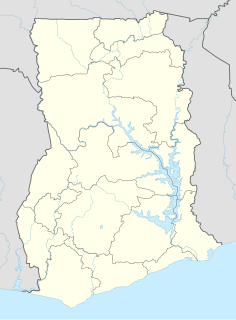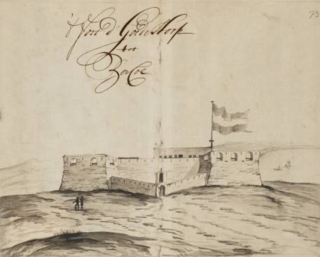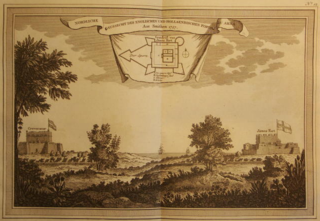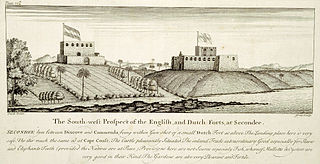 W
WFort Amsterdam, a World Heritage Site is a former slave fort in Kormantin, Central region, Ghana. It was built by the English between 1638 and 1645 as Fort Cormantin or Fort Courmantyne, and was captured by admiral Michiel de Ruyter of the Dutch West India Company in 1665, in retaliation for the capture of several Dutch forts by the English Admiral Holmes in 1664. It was subsequently made part of the Dutch Gold Coast, and remained part of it until the fort was traded with the British in 1868. The Fort is located at Abandze ,on the north-east of Cape Coast in the Mfantseman District of the Central Region of Ghana.
 W
WFort Apollonia is a fort in Beyin, Ghana. The name Apollonia was given to the area by a Portuguese explorer who sighted the place on the Feast of Saint Apollonia, 9 February.
 W
WFort Batenstein was a fort and trading post established by the Dutch on the Gold Coast in 1656. It was situated near Butre. The fort was ceded with the entire Dutch Gold Coast to Britain in 1872.
 W
WCape Coast Castle is one of about forty "slave castles", or large commercial forts, built on the Gold Coast of West Africa by European traders. It was originally a Portuguese "feitoria" or trading post, established in 1555, which they named Cabo Corso. However, in 1653 the Swedish Africa Company constructed a timber fort there. It originally was a centre for the trade in timber and gold. It was later used in the trans-Atlantic slave trade. Other Ghanaian slave castles include Elmina Castle and Fort Christiansborg. They were used to hold slaves before they were loaded onto ships and sold in the Americas, especially the Caribbean. This "gate of no return" was the last stop before crossing the Atlantic Ocean.
 W
WFort Coenraadsburg or Conraadsburg, also Fort São Tiago da Mina, is a small Portuguese chapel built in honor of Saint Jago and it is situated opposite the Elmina Castle in the Central region of Ghana, to protect Fort Elmina from attacks.
 W
WFort Elize Carthago was a fort built by the Dutch West India Company in 1702 on a hill at the mouth of the Ankobra River, near the base of the Dutch on the Western Gold Coast, Fort Saint Anthony. Today, only ruins of the former fort can be found. The ruins are easily accessible by a pathway from the Ankobra Beach Hotel and frequented by tourists who enjoy the panoramic view of the site.
 W
WElmina Castle was erected by the Portuguese in 1482 as Castelo de São Jorge da Mina, also known as Castelo da Mina or simply Mina, in present-day Elmina, Ghana. It was the first trading post built on the Gulf of Guinea, and the oldest European building in existence south of the Sahara. First established as a trade settlement, the castle later became one of the most important stops on the route of the Atlantic slave trade. The Dutch seized the fort from the Portuguese in 1637, after an unsuccessful attempt to the same extent in 1596, and took over all of the Portuguese Gold Coast in 1642. The slave trade continued under the Dutch until 1814. In 1872, the Dutch Gold Coast, including the fort, became a possession of Great Britain.
 W
WFort Prinzenstein is a fort located at Keta, Ghana which was used in the slave trade. Many such forts were built in Africa, but Prinzenstein is one of the few that lie east of the Volta River. Keta served as an open port until the Tema Harbour commenced its operation to the west in 1962. The fort has been designated a World Heritage property.
 W
WFort Fredensborg is situated along the Gulf of Guinea, in the Greater Accra Region in Old Ningo and was built in 1734. The Danish-Norwegian fort was once used as a slave trading station. However, with the abolition of the slave trade, it soon decayed such that by 1835 only one man was stationed in the fort ‘to maintain the flag’.
 W
WFort Frederiksborg, later Fort Royal, was a Danish and later English fort on the Gold Coast in contemporary Ghana. It was built in 1661, with the approval of the King of Fetu, a few hundred yards from Cape Coast Castle, which was at that time in Swedish hands, on Amanfro Hill.
 W
WFort de Goede Hoop or Fort Good Hope was a fort on the Dutch Gold Coast, established in 1667 near Senya Beraku.
 W
WFort James is a fort located in Accra, Ghana. It was built by the Royal African Company of England as a trading post for both gold and slaves in 1673, where it joined the Dutch Fort Crêvecœur (1649), and the Danish Fort Christiansborg (1652) along the coast of the then Gold Coast.
 W
WFort Komenda was a British fort on the Gold Coast, currently preserved as a ruin.
 W
WFort Kongenstein was a Danish trading fort located in Ada Foah, Ghana built in 1783. A greater portion of the fort has since been washed away by the sea waves.
 W
WFort McCarthy is a fort from the colonial British Gold Coast period in present-day Ghana.
 W
WFort Metal Cross, originally Fort Dixcove, is a military structure in Dixcove, Ghana.
 W
WFort Nassau, near Moree, Ghana, was the first fort that the Dutch established on what would become the Dutch Gold Coast.
 W
WFort Orange was built as a trading post on the Dutch Gold Coast in 1642, near Sekondi in the Western Region of Ghana. It functioned as a lodge for a while during the 1670s and that was the original purpose for the fort before it was used as a trading post. The trading post was enlarged into a fort in 1690. It was joined by an English Fort Sekondi in 1682. It was sold with the rest of the Dutch Gold Coast to the United Kingdom in 1872, and now serves as a lighthouse.
 W
WFort Patience is a Dutch-built fort located in the township of Apam, in the Central Region of Ghana.
 W
WFort Ruychaver, also Fort Ruijghaver, was a Dutch trading post in the hinterland of the Gold Coast, in contemporary Ghana. It existed between 1654 and 1660 on the banks of River Ankobra. The name of the post goes back to Jacob Ruijghaver, the director of the Dutch West India Company's possessions on the Gold Coast, who ordered its establishment.
 W
WFort San Sebastian located in Shama, Ghana is the third oldest fortification in Ghana.
 W
WFort Saint Anthony was a fort built by the Portuguese in 1515 near the town of Axim, in what is now Ghana. In 1642, the Dutch captured the fort and subsequently made it part of the Dutch Gold Coast. The Dutch expanded the fort considerably before they turned it over, with the rest of their colony, to the British in 1872. The fort is now the property of the Ghanaian state and is open to the public.
 W
WFort Sekondi, also Fort George, was an English fort on the Gold Coast, built in 1682 at Sekondi, next to the Dutch Fort Orange, which had been built in 1642. This first building was small, according to William Claridge: "[...] at Sekondi [...] Captain Henry Nurse, Agent for the English Company, also built a fort there a few years later. Both these buildings were of about the same size and only a gun-shot apart", and, "The Dutch Fort Orange was a very small place, being merely a square white house in a yard, mounting eight or ten guns on a terrace on the roof. The first English fort had been a very similar building [...]". This fort was destroyed on 1 June 1698, during the Dutch-Komenda war, and reduced to blackened outer walls. Although denied by the Dutch, reports and letters sent at the time indicated that the Dutch instigated the attack and that some plundered goods were taken to Castle Orange next-door. Attempts were made to rebuild it in 1700, though these had to be abandoned because of hostility from the indigenous population.
 W
WUssher Fort is a fort in Accra, Ghana. It was built by the Dutch in 1649 as Fort Crèvecœur, and is a day's march from Elmina and to the east of Accra on a rocky point between two lagoons. It was one of three forts that Europeans built in the region during the middle of the 17th century. Fort Crèvecœur was part of the Dutch Gold Coast. The Anglo-Dutch Gold Coast Treaty (1867), which defined areas of influence on the Gold Coast, transferred it to the British in 1868.
 W
WFort Vernon was a military structure designed to facilitate the slave trade. The Royal African Company built the fort in 1742 near Prampram, a town in the Greater Accra Region of Ghana. It was built out of cheap materials – rough stones and swish. The Danes destroyed the fort before 1783. The British rebuilt it in 1806, but it soon started to collapse and was abandoned in about 1816. It was re-occupied by the British in 1831 but was again abandoned in 1844. It subsequently became ruins.
 W
WFort Victoria is a structure in Cape Coast, Ghana. It was initially known as Phipps Tower, its name being later changed to Fort Victoria in honor of Queen Victoria.
 W
WFort Vredenburgh was a Dutch fort on the Gold Coast, established on the left bank of the Komenda River. The fort exists as preserved ruins.
 W
WFort William is a fort in Anomabu, Central Region, Ghana, originally known as Fort Anomabo and renamed Fort William in the nineteenth century by its then-commander, Brodie Cruickshank, who added one storey to the main building in the days of King William IV. It was built in 1753 by the British after they thwarted a French attempt to establish a fort at the same place. Two earlier forts had been established at the same site, one in 1640 by the Dutch, another in 1674 by the English. Fort Charles was abandoned in 1730 and destroyed.
 W
WFort Winneba was a slave fort designed to facilitate the slave trade. It was built in 1694 by the Royal African Company on the Gold Coast, in modern-day Ghana.
 W
WFort Witsen, also Fort Tacaray, was a fort on the Dutch Gold Coast, established in 1665 near Takoradi. This fort was destroyed after a few years, and in 1684 the site was abandoned. A map from 1791 shows, however, that the Dutch had renewed their presence in the fort again. The fort was handed over to Britain, along with the entire Dutch Gold Coast, on 6 April 1872, owing to the provisions of the Anglo-Dutch Treaties of 1870-1871.